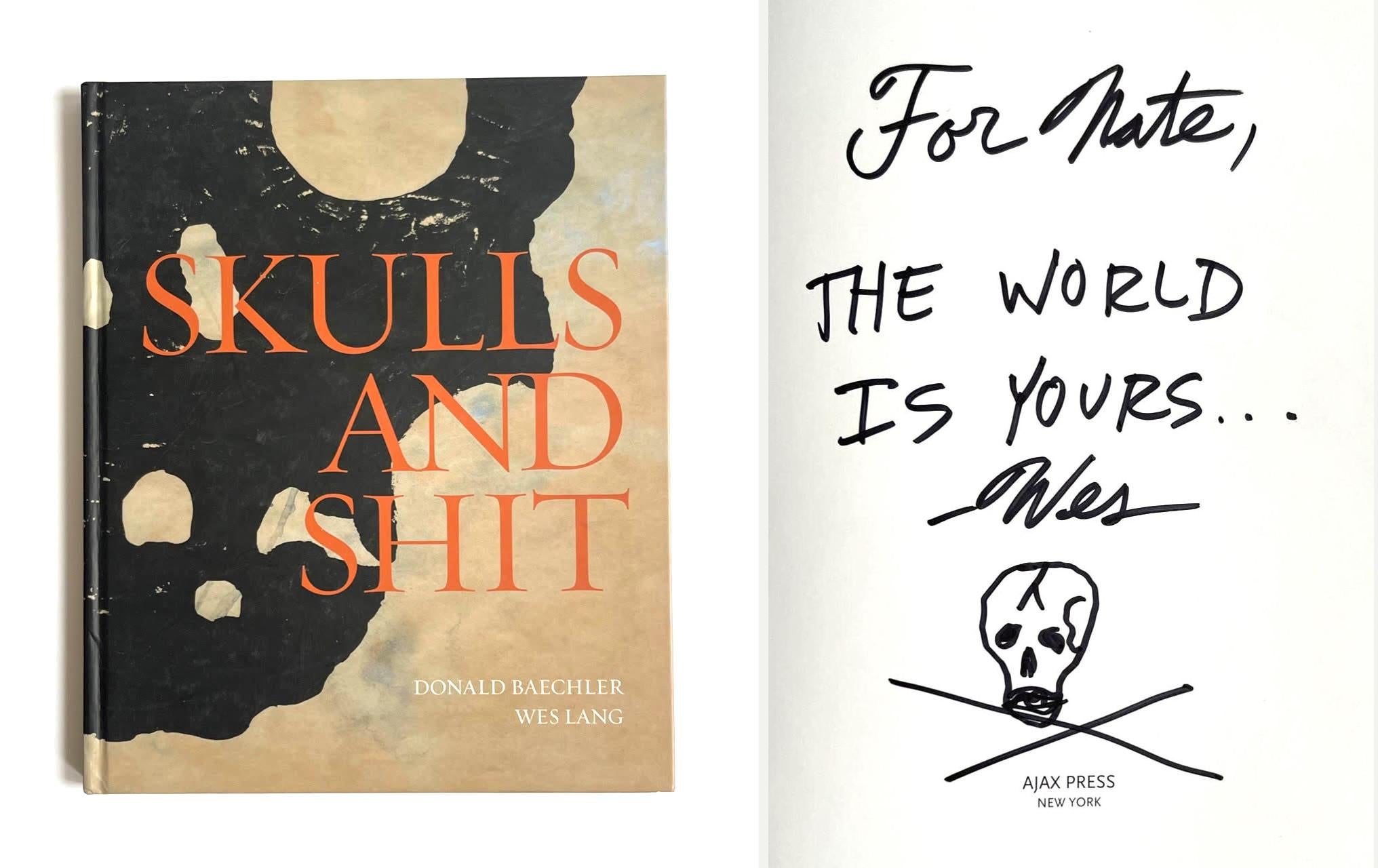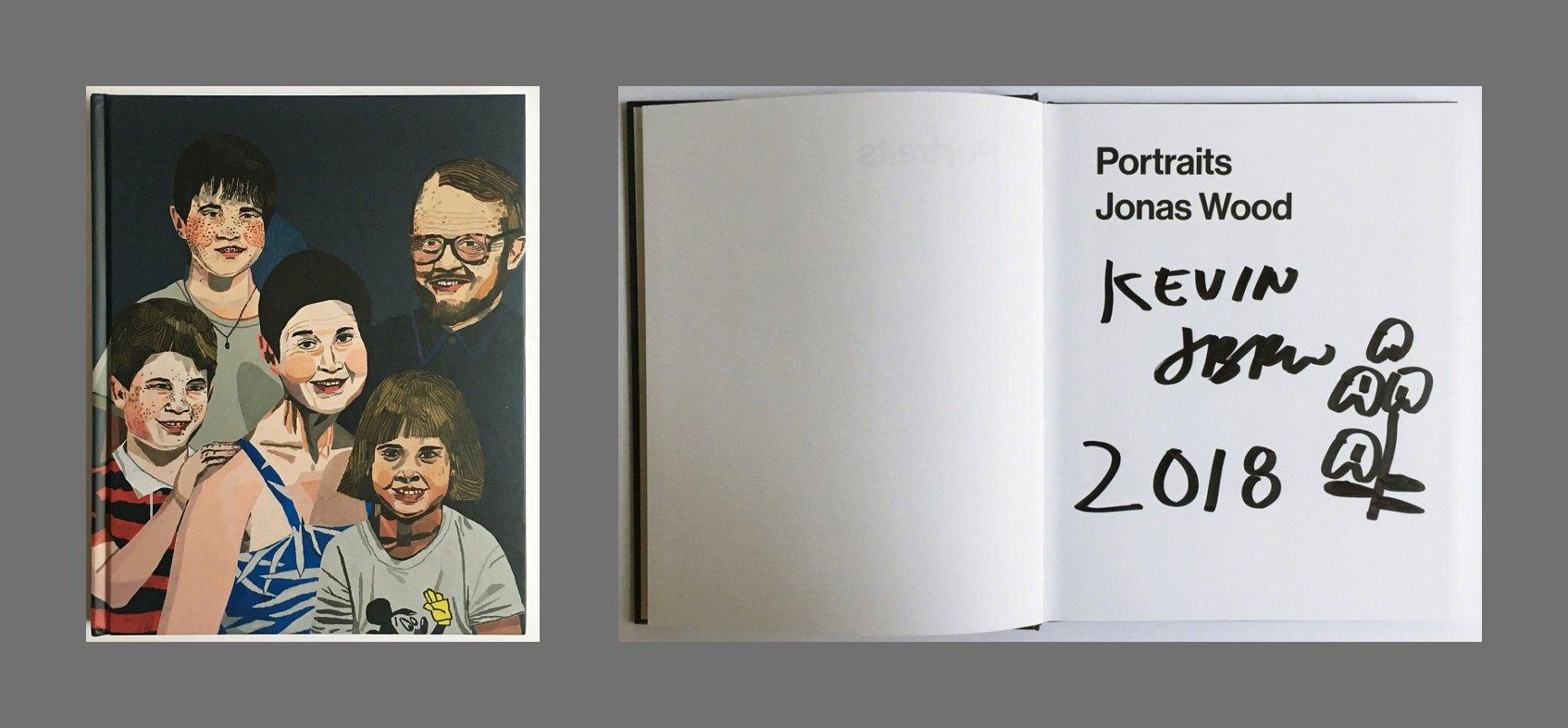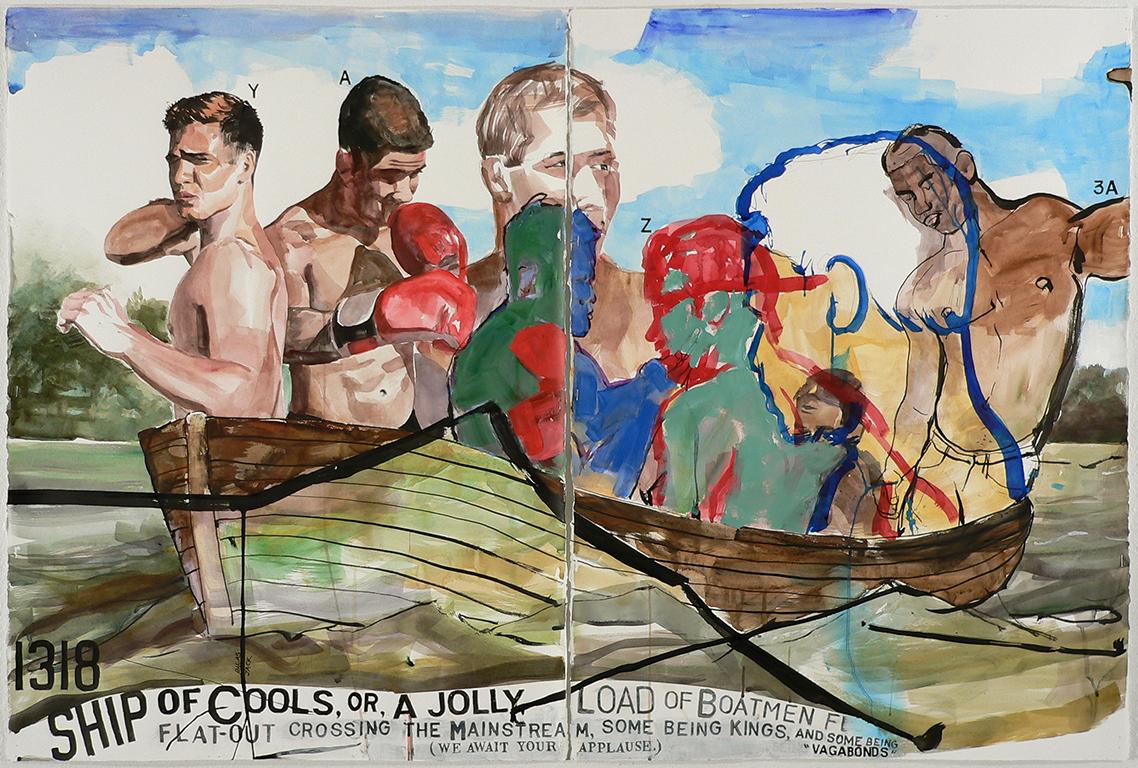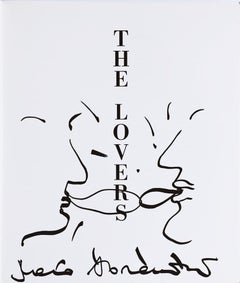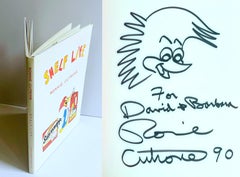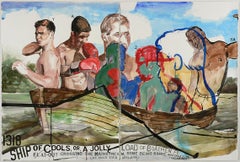Items Similar to Signed Flower drawing in monograph, inscribed to art historian Norman Rosenthal
Want more images or videos?
Request additional images or videos from the seller
1 of 12
Mark GrotjahnSigned Flower drawing in monograph, inscribed to art historian Norman Rosenthal2006
2006
About the Item
Mark Grotjahn
Black Flower (signed and inscribed to art historian Norman Rosenthal), 2006
Original flower drawing done in black marker, hand signed, titled and inscribed, bound in hardback monograph
Hand signed, dated and inscribed with flower drawing by Mark Grotjahn on the title page
12 1/4 × 9 1/4 × 1/2 inches
Unframed
This unique, original signed flower drawing is done on title page of a lavishly illustrated, 2006 hardback monograph published by Blum & Poe, with illustrated cloth boards and no dust jacket as issued.
The inscription reads:
Norman Rosenthal
[Flower Drawing] Black Flower MG
Dec 7 06
Biography of Norman Rosenthal (recipient of this drawing):
Norman Rosenthal (b.1944) is a London-based freelance curator. He first rose to prominence as the director and chief curator of the Royal Academy, a position he held between 1977 and 2008. During his tenure he worked towards assembling a variety of prodigious exhibitions, including Italian Art of the Twentieth Century (1989), the controversial Sensation: Young British Artists from the Saatchi Collection (1997), and the well-regarded Anish Kapoor retrospective of 2009. He left the Academy in 2008 to pursue a variety of self-directed projects.
In his early career Rosenthal worked at the Leicester Museum and Art Gallery before gaining valuable experience as an art researcher for London dealers and publishers Agnew and Sons. He then moved to the Brighton Museum and Art Gallery, coordinating shows as an exhibitions officer for four years before taking the position of curator at the Institute for Contemporary Art in London. His two years spent at the ICA from 1973 were of vital importance for his professional development and understanding of contemporary art.
Accorded a travel grant for his work as curator, he explored Germany, a nation rife with political tension after the student protests of 1968. It was during this journey that he met the Greek art historian and curator Christos Joachimides, who became a long-time friend and collaborator. He soon became affiliated with the avant-garde artists of the period such as Joseph Beuys, Hans Haacke, and Gustav Metzger. Having a German mother, Rosenthal spoke the language fluently, facilitating close relationships with these artists and more, including them in his first major exhibition at the Institute Art into Society; Society into Art. The show of radical German art, one of the first of its kind in London, was formed in collaboration with Joachimides.
After two years Rosenthal became displeased with the upper management of the ICA, leaving his post to begin writing for the Spectator. The current president at the time of the Royal Academy, Hugh Casson, took notice of an article criticising the institution for its lack of drive and direction. Casson forwarded it on to the Academicians, an act which in part led to Rosenthal’s hiring as exhibitions secretary. For over thirty years he oversaw events at the RA while securing numerous high-profile loans and collaborating with a plethora of revered curators. His work led to the revitalization of the museum, and the enablement of monumental exhibitions, ranging the gamut of Renaissance to contemporary art. While showcases on Frans Hals, Chardin, Goya, Mantegna and Sir Joshua Reynolds were well received, it was in contemporary art that Rosenthal would cement his status as a curator where he is most active today. Throughout his tenure at the Royal Academy he also curated exhibitions which traveled oversees, such as British Art in the Twentieth Century (1987) shown at the Staatsgalerie Stuttgart, and American Art in the Twentieth Century (1993 at the RA) which was exhibited at Martin-Gropius-Bau Berlin in 1994.
Since leaving the Royal Academy Norman Rosenthal has been involved in exhibitions with the Ashmolean Museum in Oxford, the Gagosian Gallery in New York, and the Galerie Thaddaeus Ropac in Paris.
Rosenthal has been bestowed with numerous awards in recognition of his services to art and culture, including the Iron Cross Order of Merit in 1991 (Germany), Officier, l’Ordre des Arts et des Lettres (France) in 2003 and the German British Forum Award in 2003. In 2007 he was awarded a knighthood in the Queen’s Birthday Honours List.
His versatility and unrelinquishing contribution to the contemporary art world has distinguished him as one of the foremost and celebrated curators of his generation.
Book information:
Published by Blum & Poe and Anton Kern Gallery on the occasion of the exhibition Mark Grotjahn held at Blum & Poe Los Angeles, September 8 - October 8, 2005. This catalogue features 62 lavish full color images of some of Mark Grotjahn's most well known works, including many from his famous butterfly series.
Physical description:
Hardcover, 63 pages
Los Angeles: Blum & Poe; New York: Anton Kern Gallery, 2006
About Mark Grotjahn:
Mark Grotjahn combines gesture and geometry with abstraction and figuration in visually dynamic paintings, sculptures, and works on paper. Each of his series reflects a range of art-historical influences and unfolds in almost obsessive permutations.
Grotjahn was born in Pasadena, California. He received a BFA from the University of Colorado at Boulder and an MFA from the University of California at Berkeley. While studying in California, he began his first major project, Sign Exchange (1993–98), in which he painted replicas of signs that he saw in stores around Los Angeles, then had the store owners display his hand-painted versions in place of the originals. In 1995 Grotjahn was an artist-in-residence at the Skowhegan School of Painting and Sculpture in Madison, Maine. He moved to Los Angeles a year later and, with his classmate Brent Petersen, opened the short-lived gallery Room 702.
In 2001 Grotjahn began the Butterfly series. These geometric paintings and drawings explore the constructs of dual and multi-point perspective and take on various forms as Grotjahn alters their composition and color. A selection of multicolored and monochromatic Butterfly works on paper were exhibited in 2005 at the Hammer Museum, Los Angeles. In 2018 the Los Angeles County Museum of Art presented 50 Kitchens (2013–18), from the same series, a work with more than fifty parts that all evolved from a single composition and incorporate residual traces of earlier drawings. Continuing his investigations of symmetry, perspective, and form, Grotjahn began the Face paintings in 2003. These expressive, anthropomorphic works of cardboard on canvas often feature sections cut away to reveal painted canvas beneath. As the series progresses, the faces become less apparent and more abstract, their curved lines creating void-like apertures.
Alongside his painting practice, Grotjahn has been making masks since 2000, painting cardboard boxes lying around his studio and affixing paper tubes between cut-out “eyes.” The Masks (2000–), although originally approached as a less formal project, came to assert themselves as a new armature for his painting. In 2010 Grotjahn started casting the Masks in bronze. In many of the sculptures, he incorporated and retained remnants of the bronze casting process, such as the sprues and runners, into his final work. As he does with his paintings, Grotjahn often boldly signs the Masks, allowing his signature to come forward as a compositional element. In 2014 the Nasher Sculpture Center in Dallas presented the first museum exhibition of Grotjahn’s sculpture, including small-scale and larger freestanding works.
In 2016 Grotjahn began the Capri works (2016–), seeking to break away from the Face paintings in favor of a more experimental, spontaneous working process. The first Capri works, New Capri, were modestly scaled paintings created for a private presentation at Casa Malaparte in Capri, Italy. Following this exhibition, Grotjahn created the Capri paintings (2016–), followed by the Free Capri series (2018–), in which he introduced the technique of scraping out areas of thick paint, then placing the resulting “slugs” in rows and grids elsewhere on the canvas.
As the Butterflies, Faces, Masks, and Capri series continue to expand, Grotjahn uses Instagram to further experiment with repetition and juxtaposition, employing the grid format to freely arrange images in different combinations, in a form of visual tic-tac-toe. Throughout his work, by finding variations within his immediately identifiable style, Grotjahn reveals the complexities of authorial gesture.
Courtesy to Gagosian Gallery
- Creator:
- Creation Year:2006
- Dimensions:Height: 12.25 in (31.12 cm)Width: 9.25 in (23.5 cm)Depth: 0.5 in (1.27 cm)
- Medium:
- Movement & Style:
- Period:
- Condition:
- Gallery Location:New York, NY
- Reference Number:1stDibs: LU1745215002242
About the Seller
5.0
Platinum Seller
Premium sellers with a 4.7+ rating and 24-hour response times
Established in 2007
1stDibs seller since 2022
408 sales on 1stDibs
Typical response time: 1 hour
- ShippingRetrieving quote...Shipping from: New York, NY
- Return Policy
Authenticity Guarantee
In the unlikely event there’s an issue with an item’s authenticity, contact us within 1 year for a full refund. DetailsMoney-Back Guarantee
If your item is not as described, is damaged in transit, or does not arrive, contact us within 7 days for a full refund. Details24-Hour Cancellation
You have a 24-hour grace period in which to reconsider your purchase, with no questions asked.Vetted Professional Sellers
Our world-class sellers must adhere to strict standards for service and quality, maintaining the integrity of our listings.Price-Match Guarantee
If you find that a seller listed the same item for a lower price elsewhere, we’ll match it.Trusted Global Delivery
Our best-in-class carrier network provides specialized shipping options worldwide, including custom delivery.More From This Seller
View AllUntitled original signed drawing ("The Lovers")
By Marina Abramovic
Located in New York, NY
Marina Abramovic
The Lovers, 1990
Original Drawing done in Black Marker on title page of the "Lovers" monograph
Hand signed by Marina Abramovic in black mar...
Category
1990s Contemporary Mixed Media
Materials
Printer's Ink, Permanent Marker, Mixed Media, Offset, Board, Lithograph
Original bird drawing (hand signed and inscribed by Ronnie Cutrone) in monograph
By Ronnie Cutrone
Located in New York, NY
Ronnie Cutrone
Original bird drawing (hand signed and inscribed by Ronnie Cutrone), 1990
Original signed drawing done in marker held in hardback monograph with dust jacket
Boldly signed, dated and inscribed by Ronnie Cutrone on the first front end page
11 × 9 1/2 × 3/4 inches
Original signed drawing done in marker held in monograph, dated and inscribed by Ronnie Cutrone on the first front end page.
The inscription reads:
For David & Barbara
Ronnie Cutrone 90
Book information:
Publisher: Martin Lawrence Limited Editions, (January 1, 1990)
English; Hardcover; 46 pages with 44 color and 11 monochrome illustrations
About Ronnie Cutrone:
Ronnie Cutrone (July 10, 1948 – July 21, 2013) was an American pop artist known for his large-scale paintings of some of America's favorite cartoon characters, such as Felix the Cat, Pink Panther, Woody Woodpecker and No Glove No Love.
Cutrone's paintings are colorful, lively, and less challenging than those of his contemporaries. As Andy Warhol's assistant at the Factory atop the Decker Building from 1972 until 1980, Cutrone worked with Warhol on paintings, prints, films, and other concepts, eventually co-opting Warhol's earliest work (pre-1960) as well as works by Roy Lichtenstein and others, until finally distilling those myriad influences into the style a few critics eventually labeled "Post-Pop."
He exhibited at the Niveau Gallery in 1979 with a Scottish artist called Mike Gall who showed paintings of Snoopy, Mickey and Minnie mouse, the Pink Panther and also a small series of Peter Rabbit paintings...
Category
1990s Pop Art Animal Drawings and Watercolors
Materials
Ink, Mixed Media, Permanent Marker, Lithograph, Offset, Paper
Hand signed letter of advice ("one either jumps into the water or doesn't")
By Jasper Johns
Located in New York, NY
Jasper Johns
Letter ("one either jumps into the water or doesn't"), 1996
Hand signed letter framed on top of a Time Magazine cover depicting a work by the artist
Hand signed by Jasper Johns underneath a typewritten letter by his secretary (JJ/st)
Frame Included
This listing consists of a typewritten letter, hand signed by Jasper Johns in response to one sent by the present addressee. While we do not see the fan's letter that prompted this response from Johns, it's not too difficult to guess, as Jasper Johns replies, stating, in part, "I wish I felt I could advise you but I can't. One either jumps in the water or doesn't. There doesn't seem to be any in-between." No truer words could have been spoken regarding the artist's life.
Underneath this letter, is a vintage Time Magazine cover, presumably from the same year, depicting a Jasper Johns Flag...
Category
1990s Pop Art Figurative Drawings and Watercolors
Materials
Ink, Mixed Media, Lithograph, Offset
Original unique drawing of three parrots in monograph by renowned Chinese artist
By Walasse Ting
Located in New York, NY
Walasse Ting 丁雄泉
Original three parrots drawing, 1984
Original parrots drawing done in ink with inscription held inside elegant hardback monograph with ...
Category
1980s Modern Animal Drawings and Watercolors
Materials
Paper, Ink, Mixed Media, Lithograph, Offset
No Time 4 Love, original signed & titled ink drawing on Royal Mail FDC, framed
By Tracey Emin
Located in New York, NY
Tracey Emin
No Time 4 Love drawing, 2017
Original ink drawing on a Royal Mail Art in the 20th Century 1st Day Cover
Signed, titled and dated in pen on the front
Frame included
Signed...
Category
2010s Contemporary Figurative Drawings and Watercolors
Materials
Paper, Ink, Mixed Media, Offset
Original self-portrait drawing (hand signed and inscribed)
By Marina Abramovic
Located in New York, NY
Marina Abramovic
Original self-portrait drawing (hand signed and inscribed), 2014
Ink drawing held inside hardback monograph, done at the artist's Serpentine Gallery exhibition, han...
Category
2010s Contemporary Figurative Drawings and Watercolors
Materials
Ink, Lithograph, Offset
You May Also Like
Ship of Cools (#1318)
By Jack Balas
Located in New York, NY
Full title: "Ship of Cools, or, A Jolly Load of Boatmen Flat-Out Crossing the Mainstream, Some Being Kings, and Some Being 'Vagabonds' (We Await Your Applause) (#1318)"
Watercolor, acrylic, and ink on paper (Diptych)
Signed in black ink, l.l.
This artwork references George Caleb Bingham’s 1846 painting “The Jolly Flatboatmen...
Category
2010s Contemporary Figurative Drawings and Watercolors
Materials
Paper, Ink, Acrylic, Watercolor
Rare 1950s Original Syndicated Ink Drawing Cartoon Strip Susie Q Smith Comic Art
Located in Surfside, FL
SUSIE Q. SMITH
Medium: Newspaper comics
Distributed by: King Features Syndicate
First Appeared: 1945
Creators: Linda and Jerry Walter
5.75 X 19.75
Dated August 3, 1954 in top right corner.
Like her contemporaries, Aggie Mack, Candy and Patsy Walker (before her conversion to a superhero), Susie Q. Smith was a female Archie-type — not exactly an imitator, because Archie, who had started only four years earlier, hadn't yet become popular enough to spawn imitators, but part of his genre. She attended high school, where her teachers often seemed unreasonable to her, interacted with the opposite gender in a typically adolescent way, and her parents didn't completely understand her. And she was cute and perky as only a teenage girl can be.
Susie was the star of a comic strip distributed by King Features, the biggest of the comic strip syndicates, whose other offerings have ranged from Jackys Diary to Prince Valiant...
Category
1950s American Realist More Art
Materials
Paper, Ink
Rare 1950s Vintage Syndicated Ink Drawing Cartoon Strip Susie Q Smith Comic Art
Located in Surfside, FL
SUSIE Q. SMITH
Medium: Newspaper comics
Distributed by: King Features Syndicate
First Appeared: 1945
Creators: Linda and Jerry Walter
5.5 X 19.5
Dated August 13, 1954 in top right corner.
Like her contemporaries, Aggie Mack, Candy and Patsy Walker (before her conversion to a superhero), Susie Q. Smith was a female Archie-type — not exactly an imitator, because Archie, who had started only four years earlier, hadn't yet become popular enough to spawn imitators, but part of his genre. She attended high school, where her teachers often seemed unreasonable to her, interacted with the opposite gender in a typically adolescent way, and her parents didn't completely understand her. And she was cute and perky as only a teenage girl can be.
Susie was the star of a comic strip distributed by King Features, the biggest of the comic strip syndicates, whose other offerings have ranged from Jackys Diary to Prince Valiant. King launched the strip in both daily and Sunday form in 1945. Daily, she was only in a panel at first, but it expanded into a full, multi-panel strip on February 7, 1953. In a very odd turn of events, in 1953 the Walters chose to leave King Features behind and hitch their wagon at the McNaught Syndicate. The creators were Harold "Jerry" Walter and his wife, Linda. Jerry was also responsible for Jellybean Jones, who has nothing to do with Jughead Jones's young sister, a modern-day addition to the Archie cast of characters. Together, they did The Lively Ones during the 1960s. Though each was capable of doing both major jobs in comic strip production, their usual working method was for Jerry to dream up the ideas and write the dialog, while Linda did the artwork.
The Walters also collaborated on a series of Susie Q. Smith comic books for Dell Comics. Instead of reprinting newspaper strips, these ran new stories by the Walters. Between 1951 and '54, four issues were published as part of the Four Color Comics series, where many minor comic strips, including Dotty Dripple, Timmy and Rusty Riley had found a home. It had no other media spin-offs.
Susie Q. Smith had a respectable run in the newspapers, but it ended in 1959.
Jerry Walter (1915 - 2007) was an abstract expressionist artist whose output of energetic and colorful paintings were the products of the rich artistic milieu of post-war New York City. He was born Harold Frank Walter in Mount Pleasant, Iowa on November 25, 1915. After graduating from Colgate University in 1937, Walter moved to New York City, where he studied drawing and painting at the New School and the Art Students’ League. Before concentrating seriously on his art, he spent several years as a successful copywriter and idea man for the advertising agencies of J. Walter Thompson, McCann Ericson, and BBDO. During this time, he also worked as a syndicated cartoonist. Collaborating with his wife, Linda, his best-known series was Susie Q. Smith, which first appeared in 1945 and described as a “female Archie type.” Very popular, the cartoon was later the subject of a series of comic books published from 1951 to 1954. After serving in the United States Army for three years during World War II, Walter began to paint seriously. He ascribed his earliest artistic influence to Joan Miró, whose Dog Barking at the Moon (1926) he viewed when he was twelve, the year he published his first cartoon. Walter later wrote that jazz, “the first native expression of so-called modernism” was a strong influence on his work.
During the later 1940s, Walters spent time at the Research Studio in Maitland, Florida. Founded in 1937 by artist and architect J. André Smith and supported by the philanthropist Mary Curtis Bok, the Research Studio was a lively colony that hosted prominent artists, including Milton Avery, Ralston Crawford, and Doris Lee. While at the Studio, Walter’s work was purchased by Frank Crowninshield. A founding trustee of the Museum of Modern Art and editor of Vanity Fair, Crowinshield was a noted collector; his collection included important works by Pablo Picasso, Marc Chagall, Henri Matisse, Edgar Degas, George Bellows, and Pierre Bonnard. Returning to New York after his time at the Studio, Walter became an active member of the New York school of the abstract expressionist movement, and in the summer of 1956, Walter exhibited 13 paintings and a selection of drawings at New York’s Chase Gallery. The adroit manipulation of both color and composition evident in his work shows the influence of Abstract Expressionism, particularly Willem de Kooning, Arshile Gorky, and Hans Hofmann.
illustrator and female cartoonist Linda Walter was the talented female mind behind the beloved "Susie Q. Smith" comic strip. She played an instrumental role in shaping the cultural landscape through her vibrant illustrations. Known for the timeless charm of the "Susie Q. Smith" comic strip, Linda's artistry brought joy and laughter to countless readers during the 1950s and continues to resonate with fans across generations. She was part of the Woodstock artists community. from Women in Comics: Linda Walter was the artist of newspaper strip Susie Q. Smith, which was written by her husband, Jerry. It was syndicated by King Features Syndicate and ran from 1945 to 1959. The Walters also contributed original Susie Q. Smith stories to Dell's Four Color comic books from 1951 to 1954. From 1964-1965, they created a singled panel comic called The Lively Ones.
Vintage Golden Age of Comics era.
The Golden Age of Comic Books describes an era in the history of American comic books from 1938 to 1956. During this time, modern comic books were first published and rapidly increased in popularity. The superhero archetype was created. Between 1939 and 1941 Detective Comics (DC) and its sister company, All-American Publications, introduced popular superheroes such as Batman and Robin, Wonder Woman, the Flash, Green Lantern, Doctor Fate, the Atom, Hawkman, Green Arrow and Aquaman. Timely Comics, the 1940s predecessor of Marvel Comics, had million-selling titles featuring the Human Torch, the Sub-Mariner, and Captain America. Another notable series was The Spirit by Will Eisner.
Dell Comics' non-superhero characters (particularly the licensed Walt Disney animated-character comics) outsold the superhero comics of the day. The publisher featured licensed movie and literary characters such as Mickey Mouse, Donald Duck, Roy Rogers and Tarzan. Additionally, MLJ's introduction of Archie Andrews in Pep Comics #22 (December 1941) gave rise to teen humor comics, with the Archie Comics...
Category
1950s American Modern More Art
Materials
Paper, Ink
Rare 1950s Original Syndicated Ink Drawing Cartoon Strip Susie Q Smith Comic Art
Located in Surfside, FL
SUSIE Q. SMITH
Medium: Newspaper comics
Distributed by: King Features Syndicate
First Appeared: 1945
Creators: Linda and Jerry Walter
5.5 X 17.75
Like her contemporaries, Aggie Mac...
Category
1950s American Modern More Art
Materials
Paper, Ink
Vintage Golden Age Syndicated Ink Drawing Cartoon Strip Susie Q Smith Comic Art
Located in Surfside, FL
SUSIE Q. SMITH
Medium: Newspaper comics
Distributed by: King Features Syndicate
First Appeared: 1945
Creators: Linda and Jerry Walter
6.5 X 19.5
Like her contemporaries, Aggie Mack, Candy and Patsy Walker (before her conversion to a superhero), Susie Q. Smith was a female Archie-type — not exactly an imitator, because Archie, who had started only four years earlier, hadn't yet become popular enough to spawn imitators, but part of his genre. She attended high school, where her teachers often seemed unreasonable to her, interacted with the opposite gender in a typically adolescent way, and her parents didn't completely understand her. And she was cute and perky as only a teenage girl can be.
Susie was the star of a comic strip distributed by King Features, the biggest of the comic strip syndicates, whose other offerings have ranged from Jackys Diary to Prince Valiant. King launched the strip in both daily and Sunday form in 1945. Daily, she was only in a panel at first, but it expanded into a full, multi-panel strip on February 7, 1953. In a very odd turn of events, in 1953 the Walters chose to leave King Features behind and hitch their wagon at the McNaught Syndicate. The creators were Harold "Jerry" Walter and his wife, Linda. Jerry was also responsible for Jellybean Jones, who has nothing to do with Jughead Jones's young sister, a modern-day addition to the Archie cast of characters. Together, they did The Lively Ones during the 1960s. Though each was capable of doing both major jobs in comic strip production, their usual working method was for Jerry to dream up the ideas and write the dialog, while Linda did the artwork.
The Walters also collaborated on a series of Susie Q. Smith comic books for Dell Comics. Instead of reprinting newspaper strips, these ran new stories by the Walters. Between 1951 and '54, four issues were published as part of the Four Color Comics series, where many minor comic strips, including Dotty Dripple, Timmy and Rusty Riley had found a home. It had no other media spin-offs.
Susie Q. Smith had a respectable run in the newspapers, but it ended in 1959.
Jerry Walter (1915 - 2007) was an abstract expressionist artist whose output of energetic and colorful paintings were the products of the rich artistic milieu of post-war New York City. He was born Harold Frank Walter in Mount Pleasant, Iowa on November 25, 1915. After graduating from Colgate University in 1937, Walter moved to New York City, where he studied drawing and painting at the New School and the Art Students’ League. Before concentrating seriously on his art, he spent several years as a successful copywriter and idea man for the advertising agencies of J. Walter Thompson, McCann Ericson, and BBDO. During this time, he also worked as a syndicated cartoonist. Collaborating with his wife, Linda, his best-known series was Susie Q. Smith, which first appeared in 1945 and described as a “female Archie type.” Very popular, the cartoon was later the subject of a series of comic books published from 1951 to 1954. After serving in the United States Army for three years during World War II, Walter began to paint seriously. He ascribed his earliest artistic influence to Joan Miró, whose Dog Barking at the Moon (1926) he viewed when he was twelve, the year he published his first cartoon. Walter later wrote that jazz, “the first native expression of so-called modernism” was a strong influence on his work.
During the later 1940s, Walters spent time at the Research Studio in Maitland, Florida. Founded in 1937 by artist and architect J. André Smith and supported by the philanthropist Mary Curtis Bok, the Research Studio was a lively colony that hosted prominent artists, including Milton Avery, Ralston Crawford, and Doris Lee. While at the Studio, Walter’s work was purchased by Frank Crowninshield. A founding trustee of the Museum of Modern Art and editor of Vanity Fair, Crowinshield was a noted collector; his collection included important works by Pablo Picasso, Marc Chagall, Henri Matisse, Edgar Degas, George Bellows, and Pierre Bonnard. Returning to New York after his time at the Studio, Walter became an active member of the New York school of the abstract expressionist movement, and in the summer of 1956, Walter exhibited 13 paintings and a selection of drawings at New York’s Chase Gallery. The adroit manipulation of both color and composition evident in his work shows the influence of Abstract Expressionism, particularly Willem de Kooning, Arshile Gorky, and Hans Hofmann.
illustrator and female cartoonist Linda Walter was the talented female mind behind the beloved "Susie Q. Smith" comic strip. She played an instrumental role in shaping the cultural landscape through her vibrant illustrations. Known for the timeless charm of the "Susie Q. Smith" comic strip, Linda's artistry brought joy and laughter to countless readers during the 1950s and continues to resonate with fans across generations. She was part of the Woodstock artists community. from Women in Comics: Linda Walter was the artist of newspaper strip Susie Q. Smith, which was written by her husband, Jerry. It was syndicated by King Features Syndicate and ran from 1945 to 1959. The Walters also contributed original Susie Q. Smith stories to Dell's Four Color comic books from 1951 to 1954. From 1964-1965, they created a singled panel comic called The Lively Ones.
Vintage Golden Age of Comics era.
The Golden Age of Comic Books describes an era in the history of American comic books from 1938 to 1956. During this time, modern comic books were first published and rapidly increased in popularity. The superhero archetype was created. Between 1939 and 1941 Detective Comics (DC) and its sister company, All-American Publications, introduced popular superheroes such as Batman and Robin, Wonder Woman, the Flash, Green Lantern, Doctor Fate, the Atom, Hawkman, Green Arrow and Aquaman. Timely Comics, the 1940s predecessor of Marvel Comics, had million-selling titles featuring the Human Torch, the Sub-Mariner, and Captain America. Another notable series was The Spirit by Will Eisner.
Dell Comics' non-superhero characters (particularly the licensed Walt Disney animated-character comics) outsold the superhero comics of the day. The publisher featured licensed movie and literary characters such as Mickey Mouse, Donald Duck, Roy Rogers and Tarzan. Additionally, MLJ's introduction of Archie Andrews in Pep Comics #22 (December 1941) gave rise to teen humor comics, with the Archie Comics...
Category
1950s American Modern More Art
Materials
Paper, Ink
Rare 1950s Original Syndicated Ink Drawing Cartoon Strip Susie Q Smith Comic Art
Located in Surfside, FL
SUSIE Q. SMITH
Medium: Newspaper comics
Distributed by: King Features Syndicate
First Appeared: 1945
Creators: Linda and Jerry Walter
6.5 X 18
Like her contemporaries, Aggie Mack, Candy and Patsy Walker (before her conversion to a superhero), Susie Q. Smith was a female Archie-type — not exactly an imitator, because Archie, who had started only four years earlier, hadn't yet become popular enough to spawn imitators, but part of his genre. She attended high school, where her teachers often seemed unreasonable to her, interacted with the opposite gender in a typically adolescent way, and her parents didn't completely understand her. And she was cute and perky as only a teenage girl can be.
Susie was the star of a comic strip distributed by King Features, the biggest of the comic strip syndicates, whose other offerings have ranged from Jackys Diary to Prince Valiant...
Category
1950s American Modern More Art
Materials
Paper, Ink
Recently Viewed
View AllMore Ways To Browse
Flower Drawing
London Art Dealers
Works In Progress
Mark Young
Butterfly Drawing
Store Display Sign
Oxford University Sign
Signed Goya
Norman Of London
Italian Renaissance Style Art
Flowers And Butterflies Paintings
Flowers And Butterfly Painting
Norman Black Paintings
Renaissance Flower Painting
Rosenthal Flowers
Rosenthal 1
Capri Painting
Large Dec
